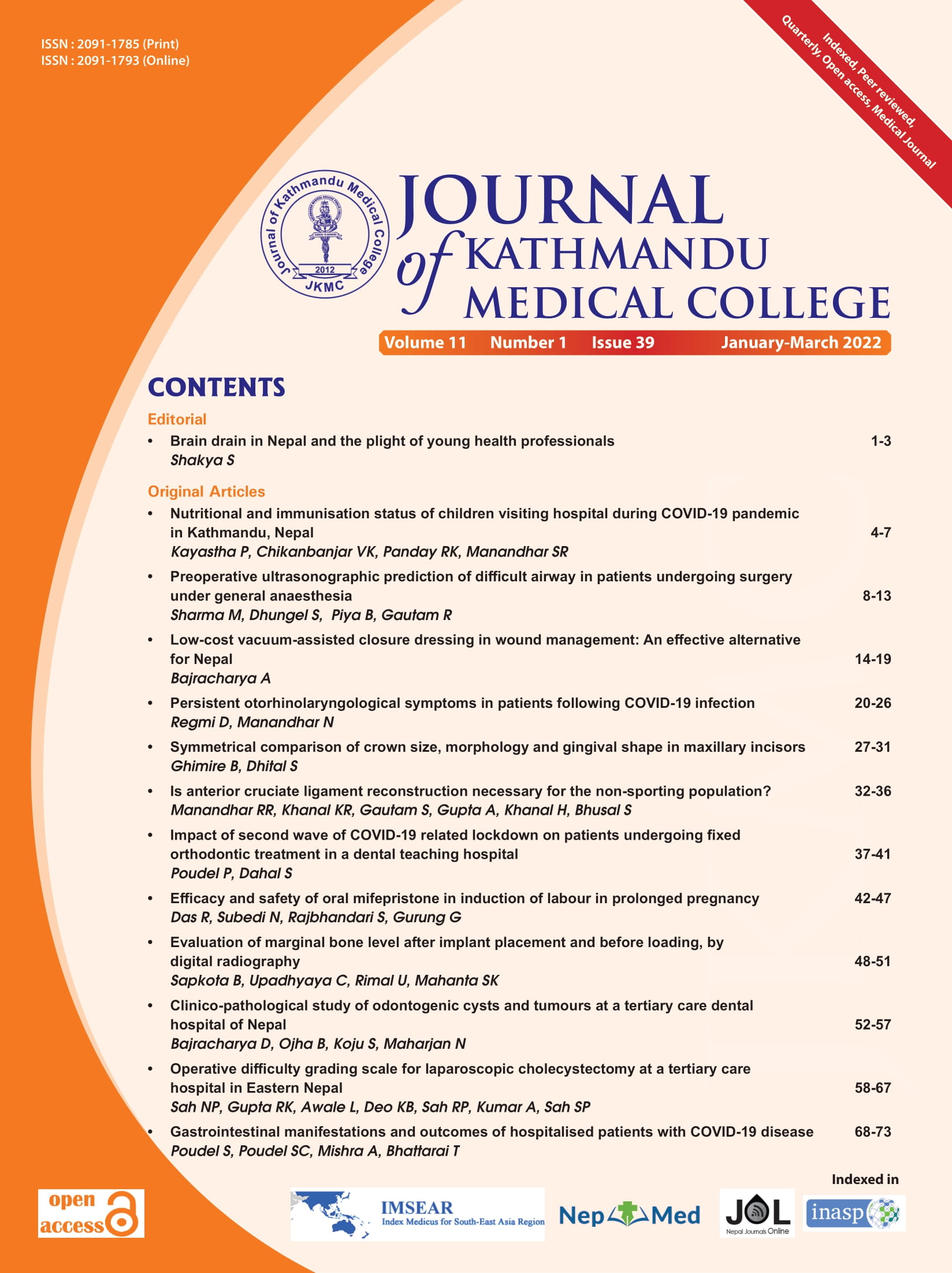Operative difficulty grading scale for laparoscopic cholecystectomy at a tertiary care hospital in Eastern Nepal
DOI:
https://doi.org/10.3126/jkmc.v11i1.45497Keywords:
Cholecystectomy, Cholecystitis, Laparoscopic, Nassar grade, SurgeryAbstract
Background: Predictions of difficult cholecystectomy preoperative make the surgeon prepared, thereby making a more careful dissection, back up from senior surgeons, and a low threshold for early conversion.
Objectives: To utilise an operative grading scale to predict open conversion, duration of surgery, total length of stay, complications and to validate Nassar score.
Methods: This was a prospective cross-sectional study done from 2020 July 9 to 2021 January 30 after ethical clearance among all patients of BPKIHS planned for laparoscopic cholecystectomy for symptomatic gallstone disease. Nassar scale was used for risk evaluation of difficult cholecystectomy. The intraoperative outcome parameters were bleeding, bile spillage, stone spillage, presence of bowel or biliary injury, operative time and conversion to open surgery. Postoperative outcomes noted were total length of stay, 30-day complications, reintervention, and mortality. The data were entered in Microsoft Excel sheet 2010 and analysis was done in SPSS v.26.
Results: Seventy-four patients were analysed. Comparison of Nassar scoring system with outcomes revealed a significant association of rising Nassar grade with bile spillage, stone spillage, bleeding, post-surgical drain placement, conversion to open, duration of surgery, and total length of stay. Operative time was significantly more in male, cholecystitis, and interval cholecystectomy. Conversion to open was significantly associated with Nassar grade 4, acute cholecystitis, and interval cholecystectomy. There was no mortality, 30-day reintervention, and complication.
Conclusion: Nassar operating scale is simple scale that can be used by all level of surgeons to predict difficult laparoscopic cholecystectomy. Rising grades have significant correlation with difficulty and complications.
Downloads
References
Jameel SM, Bahaddin MM, Mohammed AA. Grading operative findings at laparoscopic cholecystectomy following the new scoring system in duhok governorate: Cross-sectional study. Ann Med Surg. 2020;60(October):266-70. [PubMed | Full Text | DOI]
Chandio A, Timmons S, Majeed A, Twomey A, Aftab F. Factors influencing the successful completion of laparoscopic cholecystectomy. J Soc Laparoendosc Surg. 2009;13(4):581-6. [PubMed | Full Text | DOI]
Jethwani U, Singh G, Mohil RS, Kandwal V, Razdan S, Chouhan J, et al. Prediction of difficulty and conversion in laparoscopic cholecystectomy. OA Minim Invasive Surg. 2013 Aug 1;1(1):2. [Full Text]
Mann K, Belgaumkar AP, Singh S. Post-endoscopic retrograde cholangiography laparoscopic cholecystectomy: Challenging but safe. J Soc Laparoendosc Surg. 2013;17(3):371-5. [PubMed | Full Text | DOI]
Griffiths EA, Hodson J, Vohra RS, Marriott P, Katbeh T, Zino S, et al. Utilisation of an operative difficulty grading scale for laparoscopic cholecystectomy. Surg Endosc. 2019 Jan;33(1):110-21. [PubMed | Full Text| DOI]
Sudhir MS, Raj P. Preoperative grading system versus intraoperative grading system as predictors for difficult laparoscopic cholecystectomy: A comparative validation study. J Clin Basic Res. 2018;2(1):39-47. [Full Text | DOI]
Stanisic V, Milicevic M, Kocev N, Stanisic B. A prospective cohort study for prediction of difficult laparoscopic cholecystectomy. Ann Med Surg. 2020 Dec 1;60:728-33. [PubMed | Full Text | DOI]
Sugrue M, Sahebally SM, Ansaloni L, Zielinski MD. Grading operative findings at laparoscopic cholecystectomy- a new scoring system. World J Emerg Surg.2015;10(1):14. [PubMed | Full Text | DOI]
Atmaram DC, Lakshman K. Predictive factors for conversion of laparoscopic cholecystectomy. Indian J Surg. 2011 Dec;73(6):423-6. [PubMed | Full Text | DOI]
Hassan A, Zargar S, Malik A, Shah P. Surgical significance of variations in anatomy in the biliary region. Int J Res Med Sci. 2013;1(3):183. [Full Text]
Ghadhban BR. Assessment of the difficulties in laparoscopic cholecystectomy among patients at baghdad province. Ann Med Surg. 2019 Mar 27;41:16- 9. [PubMed | Full Text | DOI]
Lal P, Agarwal PN, Malik VK, Chakravarti AL. A difficult laparoscopic cholecystectomy that requires conversion to open procedure can be predicted by preoperative ultrasonography. J Soc Laparoendosc Surg. 2002;6(1):59-63. [PubMed | Full Text]
Ambe PC, Köhler L. Is the male gender an independent risk factor for complication in patients undergoing laparoscopic cholecystectomy for acute cholecystitis? Int Surg. 2015;100(5):854-9. [PubMed | Full Text | DOI]
Bazoua G, Tilston MP. Male gender impact on the outcome of laparoscopic cholecystectomy. J Soc Laparoendosc Surg. 2014;18(1):504. [PubMed | Full Text | DOI]
Coelho JCU, Dalledone GO, Schiel W, Berbardin J de P, Claus CMP, Matias JEF, et al. Does male gender increase the risk of laparoscopic cholecystectomy? Arq Bras Cir Dig. 2019;32(2):2-5. [PubMed | Full Text | DOI]
Downloads
Published
How to Cite
Issue
Section
License
Copyright © Journal of Kathmandu Medical College
The ideas and opinions expressed by authors or articles summarized, quoted, or published in full text in this journal represent only the opinions of the authors and do not necessarily reflect the official policy of Journal of Kathmandu Medical College or the institute with which the author(s) is/are affiliated, unless so specified.
Authors convey all copyright ownership, including any and all rights incidental thereto, exclusively to JKMC, in the event that such work is published by JKMC. JKMC shall own the work, including 1) copyright; 2) the right to grant permission to republish the article in whole or in part, with or without fee; 3) the right to produce preprints or reprints and translate into languages other than English for sale or free distribution; and 4) the right to republish the work in a collection of articles in any other mechanical or electronic format.




